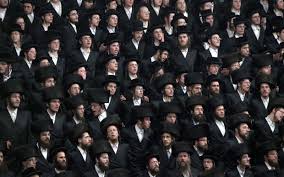My work on Super-Religiosity consists of two parts. The present essay which is theoretical and methodological in nature presents a thesis on radical religion and discusses the measures of religion. The next essay (Numen, forthcoming 2013) presents an empirical “case” to which the analytic model of Super-Religiosity is applied. The first essay may serve as a conceptual and analytic introduction to the second, while the latter one may serve as an illustration and test of the former.
Written By Gideon Aran
The religious group at the empirical focus of the two essays is the Jewish Ultra-Orthodox in contemporary Israel, known as Haredim. More precisely, the work on Super-Religiosity depicts and analyzes the hard core of the Haredi society that manifests religious extremism. The discussion of the Haredi world is harnessed to the effort to deconstruct and reevaluate the prevalent concepts of tradition and fundamentalism, and suggest new perspective on scaling religiosity and on high-scale religiosity.
I tend to support the recent claim that religion in general and religious extremism in particular, is not so much a matter of belief or experience but rather it is essentially a matter of performance of the self and the group (e.g., Asad 1993). I will argue that advancing our understanding of religious extremism requires turning the spotlight from a performance oriented towards religion’s environment to religious inward facing performance.
I will further maintain that religious extremism’s center of gravity is the in-group dynamics of competition over religious excellence rather than (rational choice) competition over external resources. Finally, I propose a measure of religiosity: one used by the practitioners of religion themselves.

The core of the article addresses the issue of the measurability of religiosity by developing a multi-dimensional model that measures religiosity, or rather, suggesting a system of parameters that defines the degree of radicalism of religious performance. I aspire to redefine radical religiosity with a two-pronged approach.
First, I challenge the prevalent models of religious radicalism that tend to be reduced to the mono-theme of the potentiality of conflict between religious groups and the world that surrounds them. The article’s contention implies additional, more subtle elements of religious radicalism.
The second point of departure is the observation that religious individuals and collectives are preoccupied with questions regarding the degree of their religiosity compared to that of others. One can detect in the religious world arch-typical sophisticated scales of religiosity that are of heuristic value. The observed phenomenon guides the construction of an ideal-type of religious radicalism. This hypothetical construct provides a foundation for a comparative program.
The application of the suggested model depicts the Haredim as very religious, even religiously extreme, and as haunted by the perplexities of the assessment of their religiosity, which is challenged by inner tension and rapid change.
I propose rethinking both Religious Radicalism and Jewish Ultra-Orthodoxy. This is conducted through an ethnographic study of a particular Haredi institution titled ZaKA (Hebrew acronym for Disaster Victim Identification). It is a volunteer organization founded in the 1990s in the wake of a series of Palestinian terror attacks, dedicated to caring for the bodies of the dead after a bombing and ensuring their proper religious burial (Stadler et al. 2005).

ZaKA leaders and activists are exclusively ultra-orthodox Jews. ZaKA is essentially a Haredi enterprise, reflecting the fundamental features of Haredi society and culture including its heterogeneity, typical inner tensions, and current transformation.
This study of Haredim is equivalent and complimentary to my previous study of another Jewish radical religious group in Israel, namely Gush Emunin (The Bloc of the Faithful. Henceforth: GE), or rather the messianic hard core of the ultra-Zionist Right wing settler movement in the West Bank (Aran 1987). Both Haredim and GE are resourceful and thriving revival movements that burst into Jewish public life in the last generations and left a decisive imprint upon it. These two religious phenomena are known as the two brands of Jewish Fundamentalism.
The two exemplify entirely different versions of Super-Religiosity. My study of GE is also based on fieldwork, mostly three years of participant observation. Some subtle yet potentially explosive matters analyzed in these two research projects and their main thrust have been crystallized, to a large degree, while the True Believers were my captive dialogue-partners, densely enclosed with me alone in a small car, driving long distances late at night. It was in this traveling confessional box of Haredi men that the following conception of Jewish Ultra-Orthodoxy in general, and the thesis on Super-Religiosity in particular, was subject to scrupulous examinations.
During one of those nocturnal rides, on the way back from some horrific terror scene, an animated conversation broke out concerning what motivates the Palestinian suicide bombers.
Naturally enough, the Haredi ZaKA volunteers expressed much rage and disgust towards the terrorists. They ascribed the latter’s evil and brutality to their “inferior Muslim religiosity.” But then, one of the young Ultra-Orthodox Jews in the car hesitantly ventured a daring speculation that the bomber who sacrificed his life for a cause he considers sacred acted out a superior kind of religiosity, may be even more elevated than their own.
A tense moment of complete silence followed. Anxiety, embarrassment and bewilderment prevailed. One could sense traces of reserved admiration, a shadow of repressed envy. At that moment the present study was born. Soon after this rare occasion of awe and self-awareness the lively conversation was re-kindled, vocal, flowing and assured.
Taken from “On Religiosity and Super-Religiosity: Measures of Radical Religion”, By Prof. Gideon Aran
